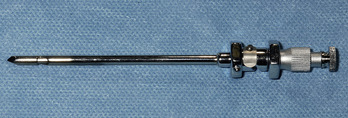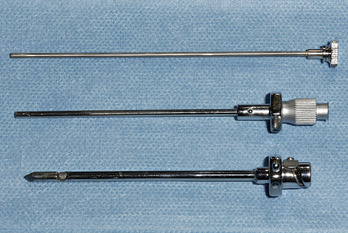CHAPTER 5. PERCUTANEOUS PLEURAL BIOPSY
Contraindications46
Equipment46
The Abrams’ needle47
Site of biopsy47
Practical procedure49
Post-procedure investigations50
Post-procedure care51
Cautions52
Complications52
Suggested reading52
Pleural biopsy, originally an open technique, has been more commonly performed blindly ever since Abrams’ description using a specialized needle in 1958. Prior to Abrams’ development, the original technique used a Franklin modification of the Vim-Silverman needle, which was used for renal biopsy. Despite Cope also describing a novel needle for pleural biopsy in 1958, the Abrams’ needle remains the most popular apparatus. Recently there has been interest in ultrasound-guided biopsies with both modified Abrams’ needles and needles that only require a single pass for multiple biopsies.
 Tip Box
Tip BoxImage guided cutting needle biopsies have a higher yield for malignancy than standard Abrams’ needle pleural biopsy.
(British Thoracic Society guidelines)
INTRODUCTION
Percutaneous pleural biopsy is occasionally performed when other means for reaching a diagnosis of an exudative pleural effusion have not been successful. Pleural aspirate examination coupled with cross-sectional imaging and cytology obtained at bronchoscopy will usually provide sufficient data to make a diagnosis. Percutaneous pleural biopsy is, however, recommended when standard cytology is non-diagnostic. The procedure is particularly useful when granulomatous or malignant disease of the pleura is suspected.
CONTRAINDICATIONS
• Coagulopathy.
• Local sepsis over biopsy site.
• Lack of consent.
EQUIPMENT
• Dressing pack.
• Sterile gown, gloves and drapes.
• Chlorhexidine cleaning solution.
• Lidocaine.
• 1 × 10 mL syringe.
• 1 × 20 mL syringe.
• Orange needle.
• Green needle.
• Skin pen
• Gauze.
• Scalpel.
• Clamped forceps (one for blunt dissection and one for chest drain insertion if required).
• If a chest drain is to be inserted post-biopsy: large-bore chest drain kit, connecting tubing, closed drainage system (with sterile water for underwater seal), suture (e.g. ‘1’ silk).
• Sterile dressing.
• 3 sterile specimen pots (for biochemistry, microscopy culture and sensitivity, cytology) and specimen pots for histology (containing formaldehyde solution).
THE ABRAMS’ NEEDLE
The Abrams’ needle consists of three separate components (Fig. 5.2):






